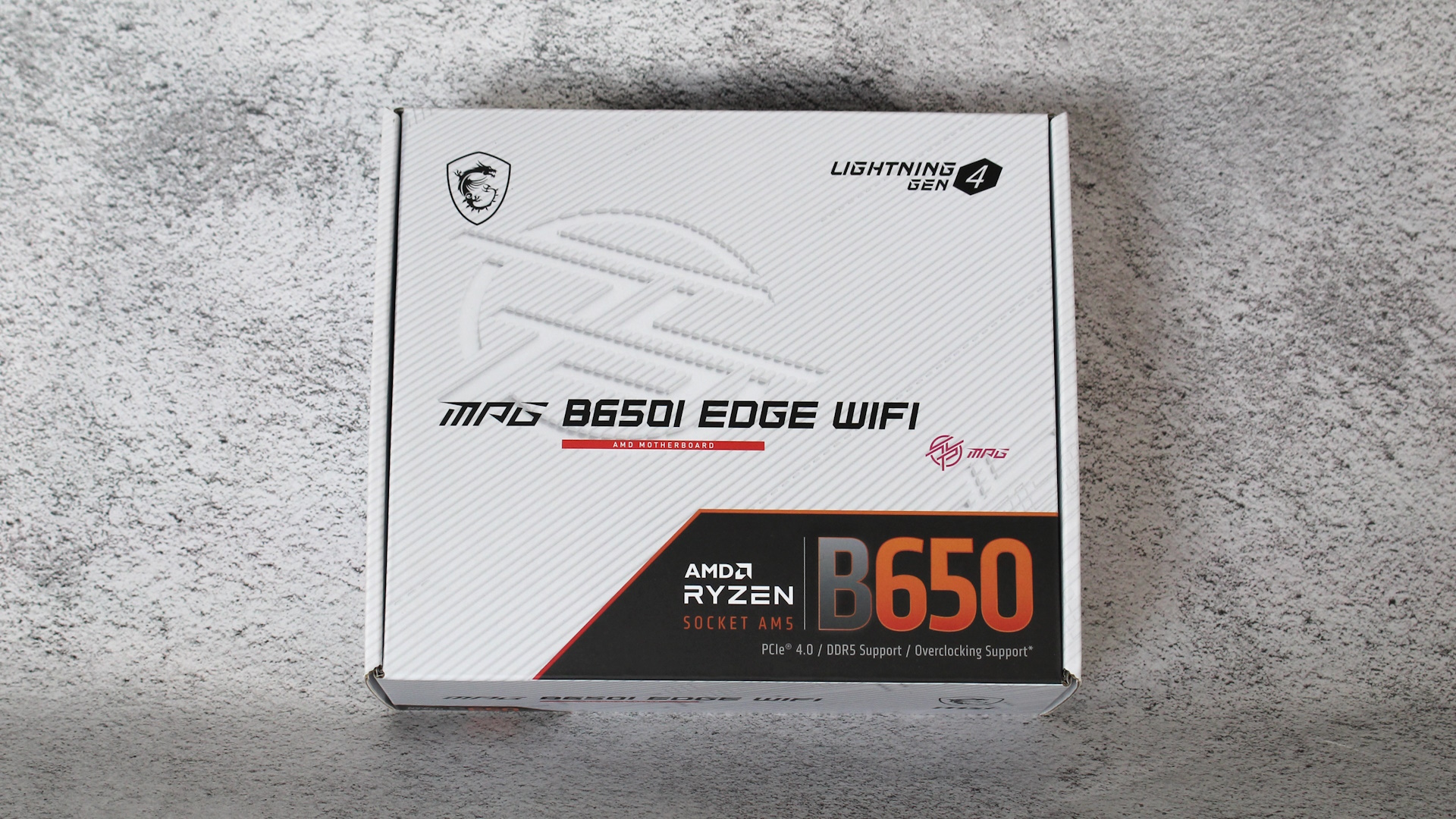Tom's Hardware Verdict
MSI’s B650 Edge Wi-Fi is a worthwhile option in the Mini-ITX space. You get all of the basics, including Zen 5 support, but five USB ports on the rear IO and a lack of a PCIe 5.0-capable M.2 socket can be a turnoff, with the competition offering more USB and fast M.2 at similar price points.
Pros
- +
Black on gray style is unique in ITX
- +
Quality audio solution
- +
2x M.2 sockets
Cons
- -
Five Type-A ports on rear IO
- -
Lacks PCIe 5.0-capable M.2
- -
Multithreading performance lower than others
Why you can trust Tom's Hardware
MSI’s B650I Edge Wi-Fi is a Mini-ITX board designed for AM5 processors. Priced at $271.86 at the time of this writing, it’s one of the least expensive Mini-ITX boards using the B650 chipset. For the money, you get plenty of connectivity and, with the latest BIOS, support for the new 9000-series processors like the 9600X and 9700X. It includes Wi-Fi 6E and 2.5 GbE, two M.2 sockets (both PCIe 4.0), capable power delivery, a quality audio codec, and power delivery capable of handling our flagship-class Ryzen 9 7950X processor. For a Mini-ITX board, it also looks good with the contrasting grey heatsink against the black PCB. Overall, it’s a well-rounded, well-priced solution in the Mini-ITX space. The B650I Edge Wi-Fi is MSI’s only Mini-ITX board for AM5 processors, but there’s plenty of competition from each major board partner.
On the performance front, the B650I Edge was all over the place. In some tests (Procyon Video/Photo editing), it was one of the fastest boards to date. But was slower in other, generally more heavily multi-threaded tests (Cinebench, Blender, POV-Ray, etc.). Gaming performance was average, so we don’t have to worry about that. But if your use case involves heavily threaded and longer-running activities, there are faster boards out there.
Below, we’ll examine the board and determine whether it deserves a spot on our Best Motherboards list. Before we proceed with testing and board specifics, though, we’ll you’ll find specifications from MSI’s website below.
Specifications: MSI B650I Edge Wi-Fi
| Socket | AM5 - LGA1718 |
| Chipset | B650 |
| Form Factor | Mini-ITX |
| Voltage Regulator | 12-Phase (8x MOSFETs for Vcore) |
| Video Ports | (1) HDMI (v2.1) |
| USB Ports | (1) USB 3.2 Gen 2x2, Type-C (20 Gbps) |
| Row 6 - Cell 0 | (3) USB 3.2 Gen 2 (10 Gbps) |
| Row 7 - Cell 0 | (2) USB 3.2 Gen 1 (5 Gbps) |
| Network Jacks | (1) 2.5 GbE |
| Audio Jacks | (3) Analog |
| Legacy Ports/Jacks | ✗ |
| Other Ports/Jack | ✗ |
| PCIe x16 | (1) v5.0 (x16) |
| PCIe x8 | ✗ |
| PCIe x4 | ✗ |
| PCIe x1 | ✗ |
| CrossFire/SLI | ✗ |
| DIMM Slots | (2) DDR5 7200+(OC)*, 128GB Capacity |
| Row 18 - Cell 0 | 1DPC 1R Max speed up to 7200+ MHz |
| Row 19 - Cell 0 | 1DPC 2R Max speed up to 6400+ MHz |
| M.2 Sockets | (2) PCIe 4.0 x4 (64 Gbps) / PCIe (up to 80mm) |
| Row 21 - Cell 0 | Supports RAID 0/1 |
| SATA Ports | (4) SATA3 6 Gbps (Supports RAID 0/1/10) |
| USB Headers | (1) USB v3.2 Gen 2, Type-C (10 Gbps) |
| Row 24 - Cell 0 | (1) USB v3.2 Gen 1 (5 Gbps) |
| Row 25 - Cell 0 | (1) USB v2.0 (480 Mbps) |
| Fan/Pump Headers | (3) 4-Pin (CPU, Pump, System fans) |
| RGB Headers | (1) 3-pin ARGB |
| Diagnostics Panel | EZ Debug LED |
| Internal Button/Switch | ✗ |
| SATA Controllers | ✗ |
| Ethernet Controller(s) | (1) Realtek Dragon RTL8125BG (2.5 GbE) |
| Wi-Fi / Bluetooth | AMD RZ616 Wi-Fi 6E (BT 5.2, 160 MHz, etc.) |
| USB Controllers | ✗ |
| HD Audio Codec | Realtek ALC4080 |
| DDL/DTS | ✗ / ✗ |
| Warranty | 3 Years |
Inside the Box of the MSI B650I Edge Wi-Fi
Inside the retail packaging and under the motherboard are just a couple of accessories to get you started. You get two SATA cables, a Wi-Fi antenna, an RGB extension cable, screws for M.2 sockets, some stickers/labels, and a quick installation guide. This is ypical for the class and form factor.
Design of the Edge Wi-Fi
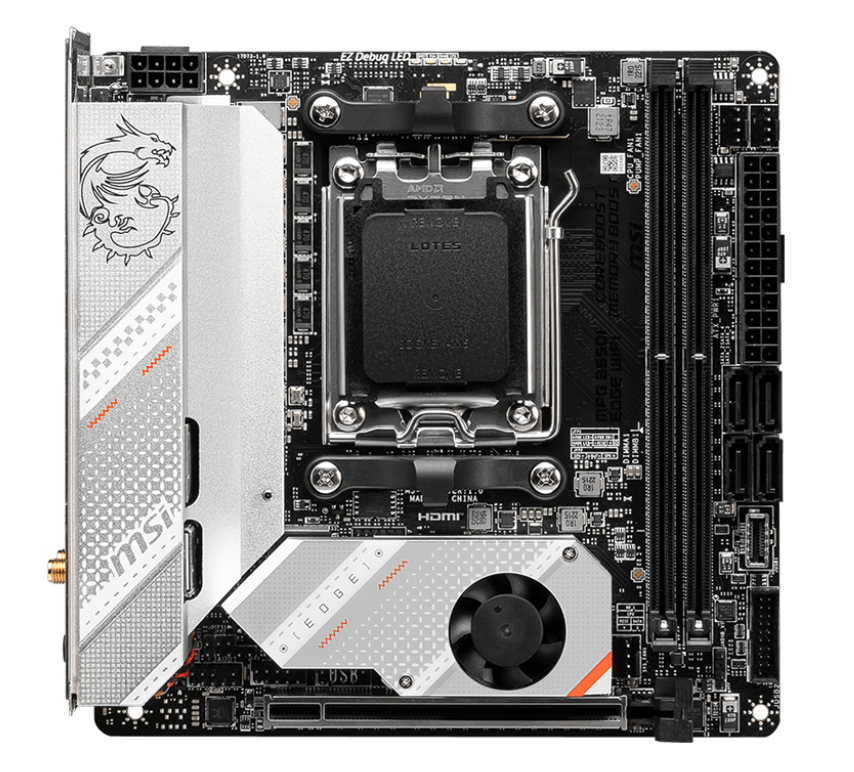
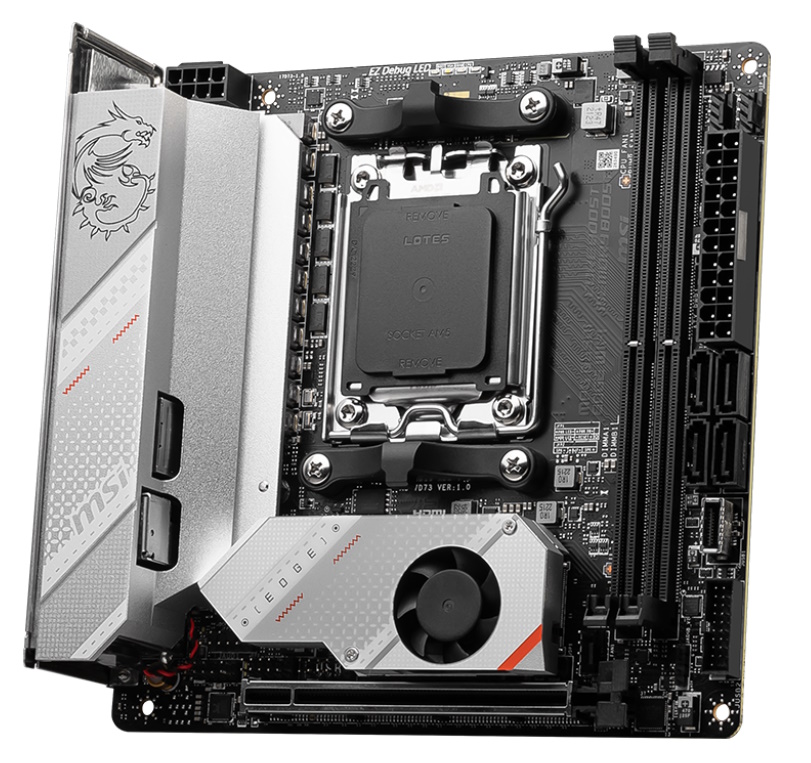
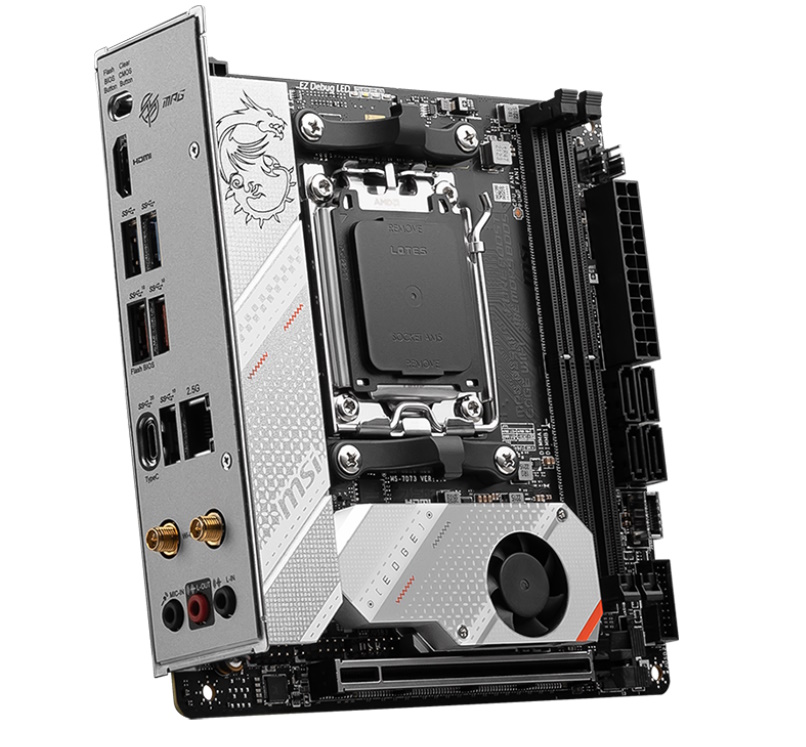
Our Mini-ITX that could is built on a 10-layer server-grade PCB with a matte finish. Large silver heatsinks cool the VRMs on the left, while a smaller but actively cooled heatsink keeps the chipset and M.2 socket cool. You’ll see the familiar MSI Dragon branding on top and MSI and Edge branding further down. Outside that, there aren’t any other design features. If you’d like to add RGB lighting, you can do so via a single 3-pin ARGB header. Overall, I like the look of Edge Wi-Fi, though some may prefer an all-black appearance. It just depends on your build’s theme.
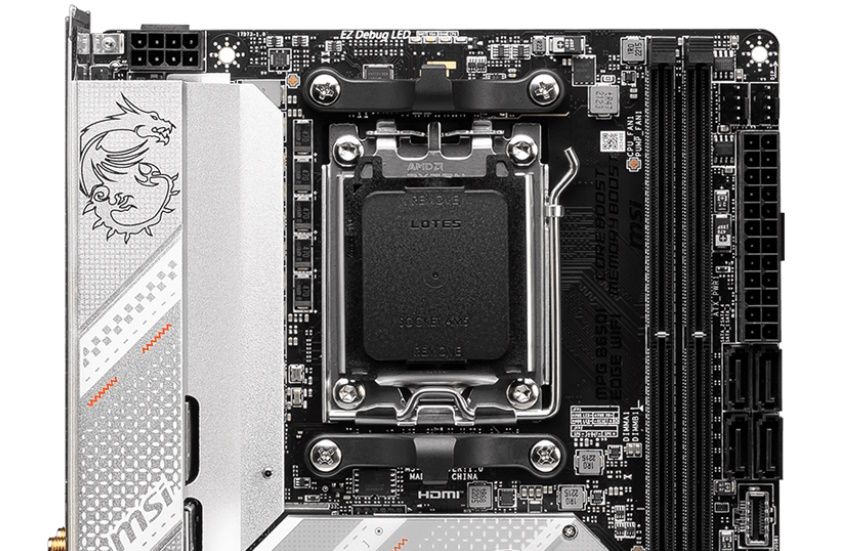
Starting in our usual location, the left corner, we spy the 8-pin EPS connector to power the processor. The VRM heatsinks are large enough and do a great job keeping the power bits below running within specification. The tiny fan is active even when idle, but it isn’t louder than the single case fan used to move air across our test bench. Even when we ran our stress test, we could barely hear it. I’d imagine you wouldn’t hear it inside a case over even more fans.
Moving right, just above the socket, are the EZ Debug LEDs. The set of four LEDs (CPU—red, DRAM—yellow, VGA—white, and BOOT—green) light up during POST. If there is an issue, the offending part’s LED remains lit, giving you a general idea of why the system isn’t booting.
Get Tom's Hardware's best news and in-depth reviews, straight to your inbox.
Next, we run into the two DRAM slots with a single locking mechanism at the top (where it should be). MSI lists support of up to 128GB of RAM with speeds listed to DDR5-7200+(OC). Our DDR5-6000 sticks worked as expected. However, our DD5-7200 kit did not want to play nice on this board (it wasn’t on the memory QVL list for 7000 series, but was for 8000 series APUs). I don’t imagine many people going that fast on this platform, but with any board, your best chance of reaching high speeds is using a kit found on their memory QVL.
Looking down the right edge, we run into the first two (of three) 4-pin fan headers. Each header supports PWM- and DC-controlled devices through the BIOS or the MSI Center application. Although there are ‘only’ three headers (normal for this size board), they can output a lot of power, allowing you to piggyback multiple fans on each. The CPU and PUMP fan headers each output 3A/36W, while the system fan header is 2A/24W. This should be plenty for a small chassis, even using a high-powered AIO or custom loop. Just make sure not to overload them.
Below the header is the 24-pin ATX connector to power the board, four vertically oriented SATA ports (supporting RAID0/1/10 modes), a front-panel USB 3.2 Gen 2 (10 Gbps) Type-C, and a 19-pin USB 3.2 Gen 1 (5 Gbps) connection.
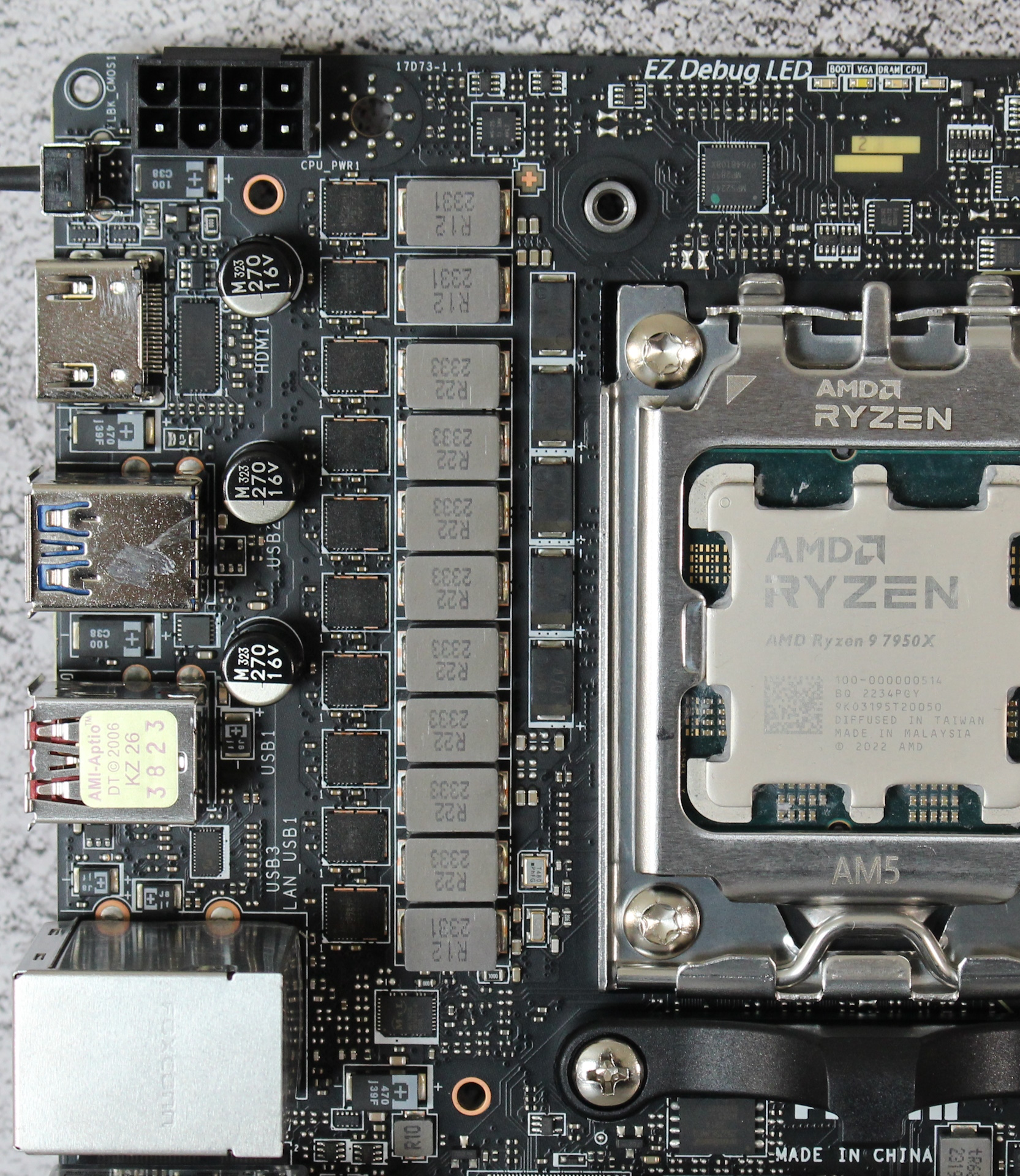
Power delivery on our little B650I Edge totals 11 phases, with eight dedicated to Vcore. Power moves from the 8-pin EPS connector onto a Monolithic Power Systems (MPS) MPS2247 controller. From there, it goes on to the eight MPS2318 MOSFETs. We’re not sure of their output, as Google doesn’t seem to have a datasheet, but it handled our high-power processor without issue.
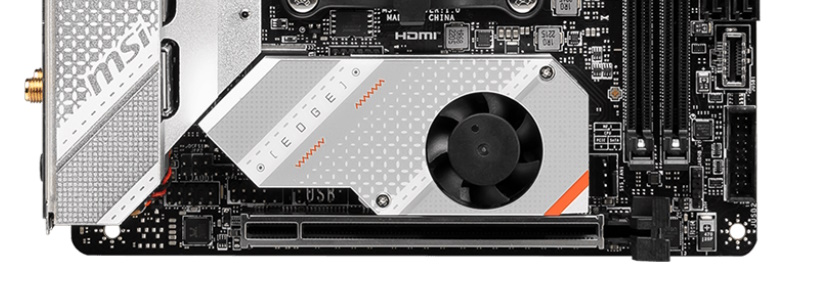
On the bottom of the board, you’ll see the mid-range Realtek ALC4080 7.1 channel codec and a couple of dedicated audio capacitors hidden below the VRM heatsink. Above that are headers for audio, front panel support, and USB 2.0. Next to that, hiding below the heatsink and fan, is the first of two M.2 sockets, with the other on the back of the board. Both sockets support PCIe 4.0 x4 (64 Gbps) speeds and hold up to 80mm modules. MSI also offers RAID0/1 for NVMe storage, while the four SATA ports support RAID0/1/10 modes. Next, a single full-length PCIe 5.0 x16 slot dominates the bottom edge of the board. And finally, next to it, is the last 3-pin fan header.
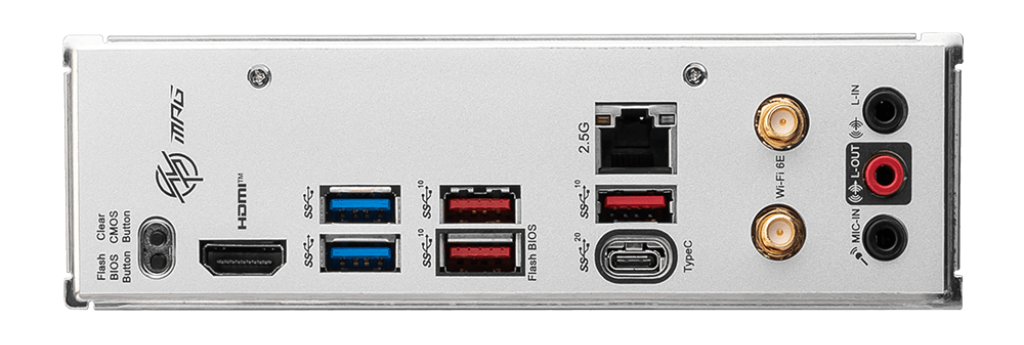
The rear IO plate comes preinstalled on the motherboard, which we expect at this price point. It has a gray background and black labels on the ports, making things easy to read. On the left, we see two tiny buttons, one to clear the CMOS and the other a BIOS Flashback feature that doesn’t require a processor to function (great if you’re planning on a 9000-series processor!). Next is the HDMI video output for use with integrated graphics on AMD APUs. There are five color-coded USB ports, with three 10 Gbps ports (red), two 5 Gbps Type-A ports, and a fast USB 3.2 Gen 2x2 (20 Gbps) Type-C port. Along with the Realtek 2.5 GbE port and AMD Wi-Fi 6E antenna connections is a simple audio stack consisting of three analog plugs.
There’s nothing out of place, but I would like to see a couple more USB ports back here. Five Type-A could be limiting for some users, and since there isn’t any expansion possible outside of the front ports, you need to know if five (plus the front) works for you.
MORE: Best Motherboards
MORE: How To Choose A Motherboard
MORE: All Motherboard Content

Joe Shields is a staff writer at Tom’s Hardware. He reviews motherboards and PC components.
-
Loadedaxe A little pricey for a B650 even at ITX, and with no pcie 5.0 nvme slots. The B650 mATX project zero has better I/O and is $65 less.Reply
All in all these AM5 boards, all of them are way too much! -
Amdlova Itx boards are too expensive. Motherboard, case, power supply are insanely over priced.Reply
It's why I have a open case with atx board. -
logainofhades ReplyAmdlova said:Itx boards are too expensive. Motherboard, case, power supply are insanely over priced.
It's why I have a open case with atx board.
Even ATX has gotten pricey, if you want a decent motherboard that doesn't have VRM's you could cook a steak on. -
jeffy9987 the pcie x16 slot is 4.0 not 5 all images/spec sheet from msi say 4.0 (https://www.msi.com/Motherboard/MPG-B650I-EDGE-WIFI/Specification)Reply -
Loadedaxe Reply
@Adminjeffy9987 said:the pcie x16 slot is 4.0 not 5 all images/spec sheet from msi say 4.0 (https://www.msi.com/Motherboard/MPG-B650I-EDGE-WIFI/Specification)
He is right, might want to fix that in the article. -
slava524 Using such a board for a month with Ryzen 7 8700G. Bought it specially for a build in a custom ITX-case.Reply
Very DYI-ish MB (with the meaning that you'll need to do some extra work on it).
A strangely high CMOS Reset button on the rear — do we really need to push it that often?? Not only me suspects that it can lead to permanent push inside of the packaging box (I guess the next point is a consequence of this)
The CMOS battery was already almost dead (so BIOS settings often reset after power-off) — had to disassemble it and change to a new CR2032 (problem solved but the warranty is gone).
Very annoying (but almost useless) chipset/ssd fan. Why do we need it here at all? Yes, one can adjust its fan curve in the BIOS to the minimums, but if your pc case is not far away under the desk you will still hear it. Will try mounting a ssd with its own fanless heatsink and watch for temps (already suspect that this should be fine).
No DP output — lots of B650 MBs not featuring it too, IDK why.Otherwise it's a rather decent middle-class board.
